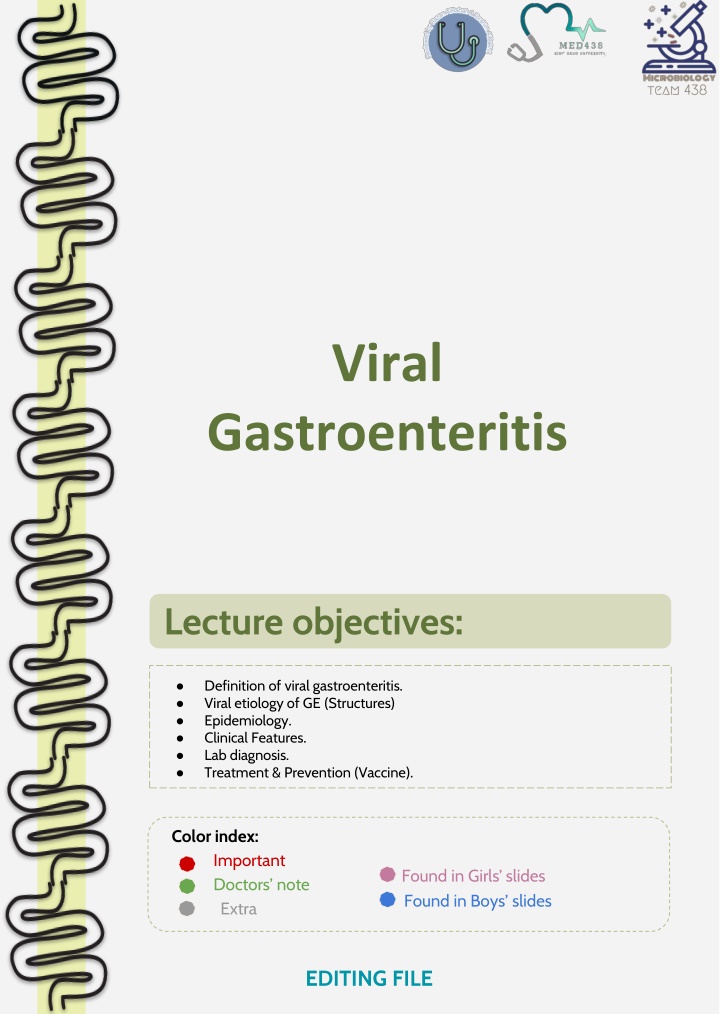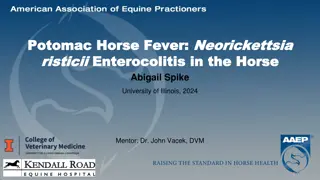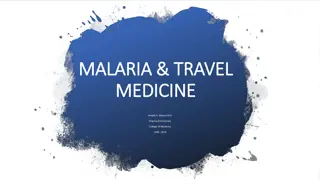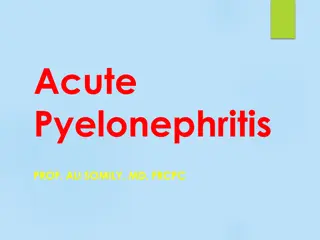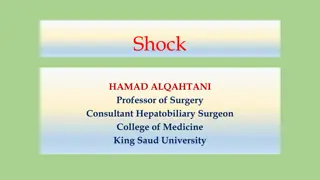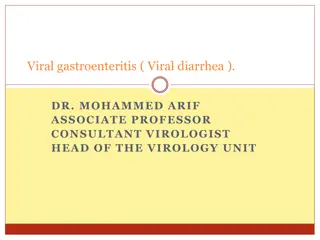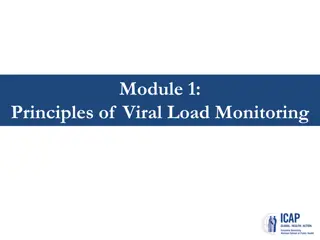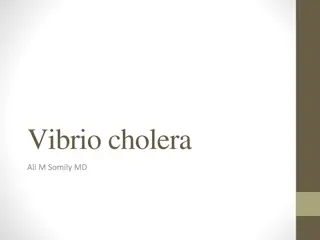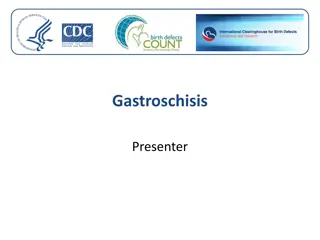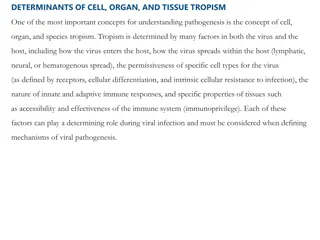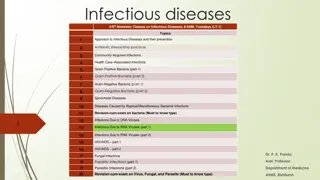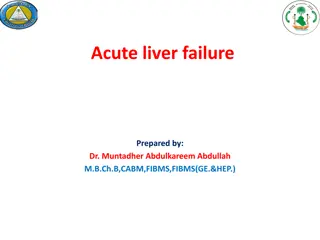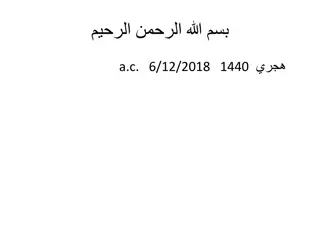Overview of Viral Gastroenteritis: Etiology, Epidemiology, Clinical Features, Diagnosis, and Treatment
Viral gastroenteritis is an inflammation of the gastrointestinal tract primarily affecting the stomach and small intestine, leading to symptoms like acute diarrhea and vomiting. It can be caused by various infectious agents such as Rotavirus, Adenovirus, Caliciviruses, Astrovirus, Coronavirus, Torovirus, and Enterovirus. The disease predominantly impacts infants and young children, often transmitted through the fecal-oral route. Clinical features include dehydration, diarrhea, vomiting, fever, and abdominal cramps. Lab diagnosis involves detecting viral antigens in stool samples through various methods. Treatment focuses on hydration and supportive care, while prevention includes vaccination.
Download Presentation

Please find below an Image/Link to download the presentation.
The content on the website is provided AS IS for your information and personal use only. It may not be sold, licensed, or shared on other websites without obtaining consent from the author.If you encounter any issues during the download, it is possible that the publisher has removed the file from their server.
You are allowed to download the files provided on this website for personal or commercial use, subject to the condition that they are used lawfully. All files are the property of their respective owners.
The content on the website is provided AS IS for your information and personal use only. It may not be sold, licensed, or shared on other websites without obtaining consent from the author.
E N D
Presentation Transcript
Viral Gastroenteritis Lecture objectives: Definition of viral gastroenteritis. Viral etiology of GE (Structures) Epidemiology. Clinical Features. Lab diagnosis. Treatment & Prevention (Vaccine). Color index: Important Doctors note Extra Found in Girls slides Found in Boys slides EDITING FILE
1 Gastroenteritis Definition It is an inflammation of the gastrointestinal tract which involves both stomach and small intestine leading to acute diarrhea and vomiting. Causes: Infectious Non-infectious: chemicals, toxins, allergy, & side effects of antibiotics. Epidemiology Worldwide; in poor hygiene, overcrowding, and poverty. Mainly infants & young children > older children. Transmit by faecal-oral route. Peaks in winter months. Endemic2infection: group A Rotavirus & Adenovirus 40 & 41 in children. Epidemic2 infection: Norovirus (from Caliciviruses) in Adults. The most common cause of non-bacterial outbreak of GE. Etiologic agents in severe diarrheal illnesses requiring hygiene and rehydration of infants & young children. (we can see that rotavirus is the most common in both developing and developed countries.) Rotavirus. (Most common & can cause severe infection in children) Adenovirus serotype 40 & 41.1 Etiology Caliciviruses (Norovirus/ norwalk virus) Astrovirus. Others: Coronavirus, Torovirus, and Enterovirus. Clinical Features Dehydration with decreased Na+ is a Life threatening condition caused by diarrhea and vomiting. Symptoms: NON BLOODY diarrhea (watery), vomiting, fever, and abdominal cramps. Winter vomiting disease3: Vomiting more than diarrhea (caused by calicivirus) Incubation period: short (1-2 days in Rotavirus) 1- Adenovirus has 51 serotypes but only serotype 40 and 41 can cause gastroenteritis (also called group F). 2- Endemic: A disease that exists permanentlyin a particular region or population. e.g. Malaria is a constant worry in parts of Africa. Epidemic: An outbreak of disease that attacks many peoples at about the same time and may spread through one or several communities. 3- A type of GE caused by calicivirus.
2 Viral Gastroenteritis Virus Rotavirus Enteric Adenoviruses Family Reoviridae (Respiratory Enteric Orphan) Adenoviridae. - Non-enveloped. - 11 segments ds-RNA. - Double-layered icosahedral capsid. - 70 nm. - RNA-dependent RNA polymerase4. - Non-enveloped. - ds-DNA. - Icosahedral capsid. Description1 Morphological Features Double-shelled with wheel-like structure. Classical icosahedral capsid with fibers. - Most common cause of gastroenteritis - Affect all age groups but mainly infants 6-24 months.(Symptomatic infection) - Endemic The 2nd most common cause of gastroenteritis Epidemiology Adenovirus has 6 subgenera (A-F) (7 subgenera (A-g))which is composed of 51 (>50) serotypes, but only enteric adenoviruses causes gastroenteritis. - Grow in cell culture. Enteric Adenoviruses: - Subgenus F, 40 & 41 serotype. - Fastidious Has 7 groups (A-G). Most common: group A. Classification Outcomes vary: - 1 2 of all GE cases requires admission. - Developed countries have low mortality. - Developing countries have significant mortality. - Deaths are reported - The only virus with fiber protruding from each of the vertices of the capsid. - Fibers for: 1- Attachment, 2- Hemagglutinin2 3- Type-specific Ag. Special informations - Most common cause of gastroenteritis in infants (Infantile GE) & young children (GE) - IP= 1-2 days. - Watery, non-bloody diarrhea with vomiting & fever. - Dehydration5. Intestinal infection: - GE in infants & young children. - Asymptomatic in older children & adults6. - Chronic diarrhea in low immune hosts. Extra-intestinal infection: - Encephalitis in small number of cases. In comparison to Rotavirus: - Longer IP. - Less severe. - Prolonged illness. Clinical Features Immunoassay: (Most used) Viral Ag in stool7samples by ELISA & Immunochromatography & latex agglutination. Others: EM, Gel electrophoresis, RT-PCR & Cell culture Viral Ag in stool samples by ELISA & Immunochromatography Diagnosis: 1- ALL viruses are non-enveloped, thus they are more stable in the harsh environment, and stomach acidity. 2- Glycoproteins which cause red blood cells to agglutinate(clump together forming aggregates). This process is called hemagglutination. 4- transcribe mRNA from the 11 segmented dsRNA (it s own genome) 5- Major complication & the cause of death. 6- However, they are source of infection to other susceptible patients (neonates & childrens) 7- Sample collected in the first few days of illness higher number of viruses.
3 Viral Gastroenteritis Caliciviruses (Norovirus) Virus Astroviruses Family Caliciviridae (Calyx=cup). Astroviridae (astro=a star). - Non-enveloped. - ss-RNA with +ve polarity1 - Icosahedral capsid. - Non-enveloped. - ss-RNA with +ve polarity. - Icosahedral capsid Description Morphological Features1 Cup-like depression on its surface. 5 or 6-pointed star on its surface. - Faecal-oral (water, shellfish). - All age groups. - Outbreaks of GE in schools, camps & cruises. - All age group Epidemiology - Two morphologic types: 1- Typical Caliciviruses (Sapovirus). 2- Small round structured viruses (Norovirus). Classification 8 serotypes. Clinical Features Children: vomiting (projectile) Adults: diarrhea. - Mild GE - Outbreak of diarrhea in children <5 yr. Viral Ag in stool samples by ELISA & Immunochromatography Viral Ag in stool samples by ELISA & Immunochromatography Diagnosis Enteric Adenoviruses Rotavirus Caliciviruses (Norovirus) Astroviruses 1- acts directly as a viral mRNA, because it has a base sequence similar to mRNA.
4 Viral Gastroenteritis Pathogenesis:1 Rotavirus infects villus cells of the proximal small intestine. The virus replicates intracellularly and eventually causes lysis in host cell. Cell destruction results in a significant decrease in intestinal surface area and consequently absorption from the intestinal lumen, thus causing watery diarrhea. Lab Diagnosis Immunochrom atography: Electron microscopy2: -Catch all tech -not used (expensive). ELISA3: Latex Cell culture: agglutination,gel electrophoresis, and RT-PCR2; Secondary tests for Rotavirus. for detection of viral Ag in stool samples. for detection of viral Ag in stool samples. Fastidious Growing poorly not used Complications: Dehydration with decreased Na+(life threatening) Prevention: Sanitation & hygiene measures. No vaccines except for Rotavirus: live attenuated vaccine, oral; Rotarix, RotaTeq & Rotashield (withdrawn)4 Treatment: Self-limiting, treated by rehydration5, and supportive treatment. 1- It s for Rotavirus, but Dr. Abdulkarim says it applies for all 4 viruses. 2- The ability of EM to catch all viruses from a single examination. 3- The major method to diagnose, due to the high sensitivity and specificity. 4- Not used anymore due to its adverse effects, now a days Rotarix and RotaTeq are used. 5- Oral or IV rehydration.
Quiz: 5 Q1:A, Q2:C, Q3:A, Q4:B, Q5:C Q6:C MCQ: Q1:Which of the following describes rotavirus? A- Non-enveloped, ds-RNA B- Non-enveloped, ds-DNA C- Non-enveloped, ss-RNA D- None of the above. Q2:Which of the following is true regarding Gastroenteritis caused by Calicivirus(Norovirus)? A- Can be prevented by vaccines. B- Children usually experience diarrhea more than vomiting C- Children usually experience vomiting more than diarrhea D- Affects children only Q3:Which of the following viruses can be prevented by vaccines? A- Rotavirus. B- Adenovirus C- Caliciviruses D- Astrovirus Q4:A 14 month old child is brought to the pediatrician with a case of diarrhea which his mother describes as explosive , loose, and watery. She hasn t noticed any blood in the stools. Prior to yesterday s onset of diarrhea, the baby had been vomiting for 2 or 3 days. Some tests showed that the causative agent is non-enveloped, dsDNA. Which of the following is most likely the causative agent? A- Rotavirus. B- Adenovirus C- Caliciviruses D- Astrovirus Q5:What type of vaccine is used for Rotavirus? A- Live attenuated vaccine, IV B- Inactivated killed antigen, oral C- Live attenuated vaccine, oral D- Purified antigen, IV Q6: When suspecting viral gastroenteritis in children, what type of sample is used for immunoassay, and for the detection of what? A- Stool sample, viral antibodies B- Blood sample, viral antibodies C- Stool sample, viral antigen D- Blood sample, viral antigen SAQ: CASE: In the month of january, a 2-year-old girl is brought to her pediatrician by her parents because of a 3-day history of watery, nonbloody diarrhea, nausea, vomiting, and abdominal pain. Physical examination reveals the child is slightly tachycardic, with sunken eyes and poor skin turgor. Q1:What s the most likely diagnosis? A: Viral gastroenteritis Q2:What are the most likely causative organisms? A: Rotavirus. Adenovirus serotype 40, & 41. Caliciviruses (Norovirus). Astrovirus. Q3: Describe each organism you mentioned above? A: Rotavirus: dsRNA, non-enveloped Adenovirus serotype 40, & 41: dsDNA, non-enveloped Caliciviruses: ssRNA, non-enveloped Astrovirus: ssRNA, non-enveloped Q4: How are they transmitted(Route of transmission)? A: Faecal-oral route Q5: How do we diagnose these organisms? A: ELISA / Immunochromatography for detection of viral Ag in stool samples. Q6: How can we prevent this disease? A: We can only prevent rotavirus by vaccines like Rotarix, RotaTeq.
Members board: Team Leaders: Abdulaziz Alshomar Ghada Alsadhan Team sub-leader: Mohammed Alhumud This lecture was done by: Alwaleed Alzunaidi Naif Alhoseini Note takers: - - - Mashal Abaalkhail Badr Alqarni Razan AlRabah
